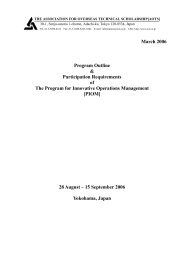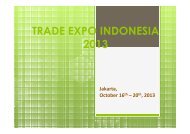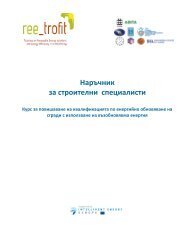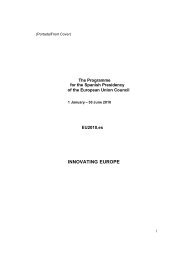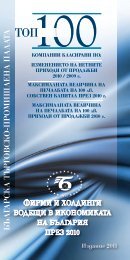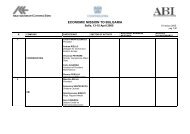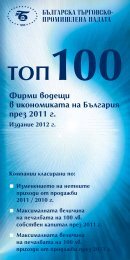Analysis of the Operation and Financial Condition of the Enterprise
Analysis of the Operation and Financial Condition of the Enterprise
Analysis of the Operation and Financial Condition of the Enterprise
Create successful ePaper yourself
Turn your PDF publications into a flip-book with our unique Google optimized e-Paper software.
<strong>Analysis</strong> <strong>of</strong> <strong>the</strong> <strong>Operation</strong> <strong>and</strong> <strong>Financial</strong> <strong>Condition</strong> <strong>of</strong> <strong>the</strong> <strong>Enterprise</strong>Table 5.22.Composition <strong>of</strong> <strong>the</strong> <strong>Enterprise</strong> N accounts receivable in percent in <strong>the</strong> periodfrom 13/12/2XX8 to 31/12/2XX9Dec.,2XX8March,2XX9June,2XX9Sept.,2XX9Dec.,2XX9Accounts receivable 100,0 100,0 100,0 100,0 100,0Accounts payable, which are not yet due 39,9 54,5 28,8 19,6 31,8Accounts receivable overdue for up to 30days 5,8 5,5 9,2 9,0 7,1Accounts receivable overdue for up to 120days 13,4 10,2 19,7 9,0 5,6Accounts receivable overdue for more than120 days 40,9 29,8 42,3 62,4 55,5It can be seen according to Tables 5.21 <strong>and</strong> 5.22 that <strong>the</strong> largest amount <strong>of</strong> accountsreceivable in <strong>the</strong> period from <strong>the</strong> end <strong>of</strong> 2XX8 to <strong>the</strong> end <strong>of</strong> March, 2XX9, is made up <strong>of</strong><strong>the</strong> direct accounts receivable, for which <strong>the</strong> term is not yet due, because at that time amajor project has been implemented by <strong>the</strong> enterprise <strong>and</strong> <strong>the</strong>re were no particularproblems with <strong>the</strong> payment for <strong>the</strong> works performed. After <strong>the</strong> most active part in <strong>the</strong>implementation <strong>of</strong> this project was over, <strong>the</strong> amount <strong>of</strong> those accounts receivable whichwere not yet due, reduced by one half, while <strong>the</strong> amount <strong>of</strong> those accounts receivableoverdue for more than 120 days was gradually increased. This amount is mainly consists <strong>of</strong><strong>the</strong> most recent project realisation invoices for <strong>the</strong> works performed as <strong>the</strong> buildingcontractors did not pay in due time. When <strong>the</strong> invoices are not paid by debtors, <strong>the</strong>yacquire <strong>the</strong> current assets <strong>of</strong> ano<strong>the</strong>r enterprise at <strong>the</strong>ir disposal, which <strong>the</strong>y use for <strong>the</strong>irown needs until <strong>the</strong> court decision is passed. The period <strong>of</strong> time before a court ruling ispresented may reach more than a year, <strong>the</strong>refore, some debtors, unfortunately, choose notto pay for <strong>the</strong> final works performed, to use <strong>the</strong> current assets <strong>of</strong> ano<strong>the</strong>r enterprise formore than one year <strong>and</strong> when <strong>the</strong>re is a strong probability that <strong>the</strong> court ruling could bepresented in a short time, try to agree on a settlement.It is on account <strong>of</strong> a settlement that in Quarter 4 <strong>of</strong> 2XX9 <strong>the</strong> amount <strong>of</strong> accountsreceivable overdue for more than 120 days was reduced. It can be seen from Tables 5.21<strong>and</strong> 5.22 that <strong>the</strong> percentage <strong>of</strong> accounts receivable from total current assets has beenreduced from 40.9 to 29.8 percent, <strong>and</strong> this is not, however, on <strong>the</strong> account <strong>of</strong> <strong>the</strong> decreasein accounts receivable overdue for more than 120 days, but on <strong>the</strong> account <strong>of</strong> an increase in<strong>the</strong> total amount <strong>of</strong> accounts receivable, because <strong>the</strong> total amount <strong>of</strong> accounts receivablehas increased by almost 80 thous<strong>and</strong> CU as <strong>of</strong> March, 2XX9.Upon analysing <strong>the</strong> composition <strong>of</strong> accounts receivable it can be concluded thatsuch a high percentage <strong>of</strong> accounts receivable from total assets is not positive, because 40to 60 percent on average from total accounts receivable are made up particularly <strong>of</strong>doubtful debts, in which more than 90 thous. CU are suspended. A recommendation shouldbe given to <strong>the</strong> enterprise to develop a set <strong>of</strong> criteria, on what conditions <strong>and</strong> after whatperiod <strong>of</strong> time overdue for payment <strong>of</strong> a debtor’s debt <strong>the</strong> enterprise must prepare all <strong>the</strong>documents necessary for submission to <strong>the</strong> court.113



